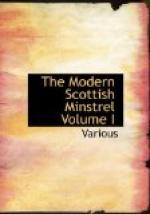In stature, Sir Walter Scott was above six feet; but his personal appearance, which had otherwise been commanding, was considerably marred by the lameness of his right limb, which caused him to walk with an awkward effort, and ultimately with much difficulty. His countenance, so correctly represented in his numerous portraits and busts, was remarkable for depth of forehead; his features were somewhat heavy, and his eyes, covered with thick eyelashes, were dull, unless animated by congenial conversation. He was of a fair complexion; and his hair, originally sandy, became gray from a severe illness which he suffered in his 48th year. His general conversation consisted in the detail of chivalric adventures and anecdotes of the olden times. His memory was so retentive that whatever he had studied indelibly maintained a place in his recollection. In fertility of imagination he surpassed all his contemporaries. As a poet, if he has not the graceful elegance of Campbell, and the fervid energy of Byron, he excels the latter in purity of sentiment, and the former in vigour of conception. His style was well adapted for the composition of lyric poetry; but as he had no ear for music, his song compositions are not numerous. Several of these, however, have been set to music, and maintain their popularity.[72] But Scott’s reputation as a poet is inferior to his reputation as a novelist; and while even his best poems may cease to be generally read, the author of the Waverley Novels will only be forgotten with the disuse of the language. A cabinet edition of these novels, with the author’s last notes, and illustrated with elegant engravings, appeared in forty-eight volumes a short period before his decease; several other complete editions have since been published by the late Mr Robert Cadell, and by the present proprietors of the copyright, the Messrs Black of Edinburgh.




